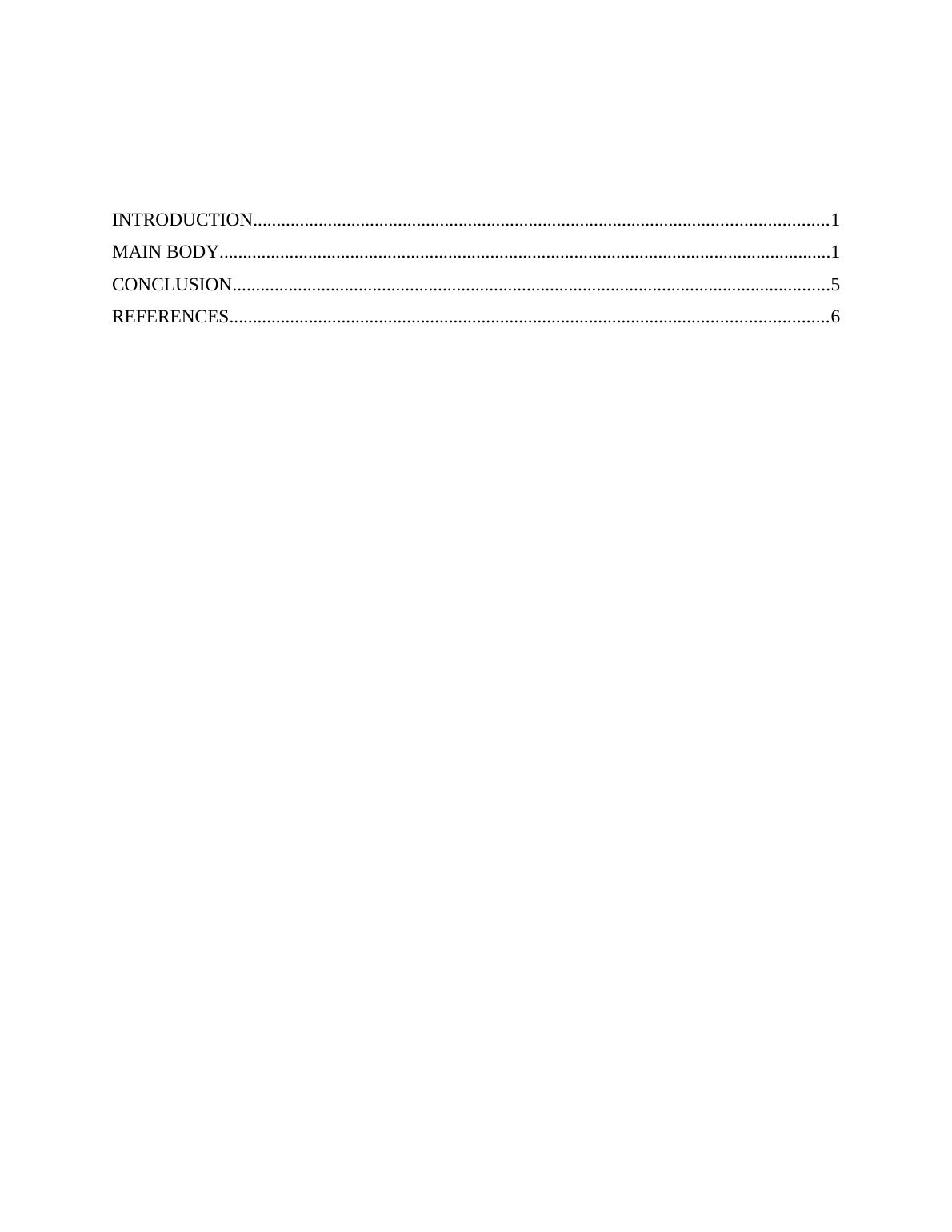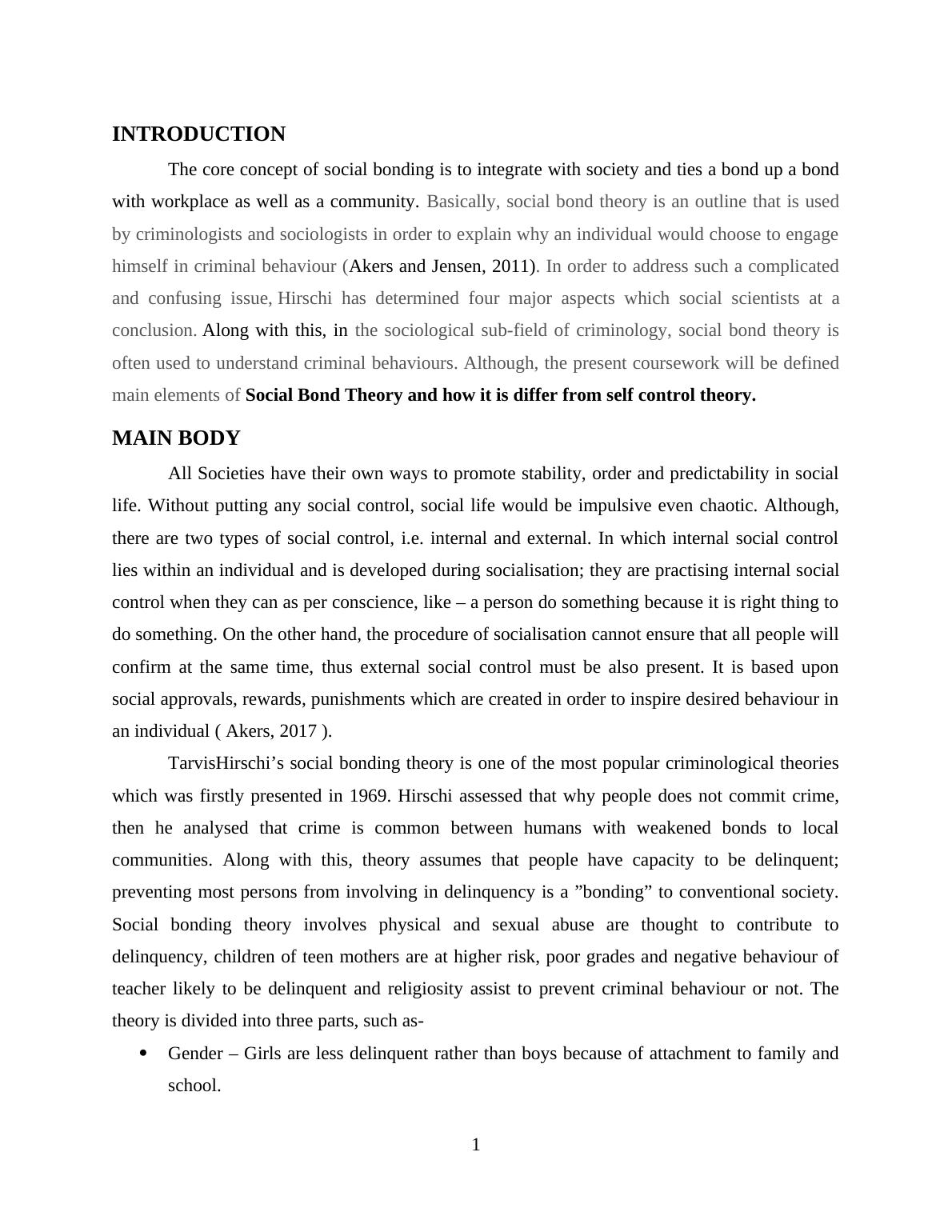Assignment Social Bonding Theory
Added on 2020-06-04
11 Pages2841 Words241 Views

MAIN BODY...................................................................................................................................1CONCLUSION................................................................................................................................5REFERENCES................................................................................................................................6

INTRODUCTIONThe core concept of social bonding is to integrate with society and ties a bond up a bondwith workplace as well as a community. Basically, social bond theory is an outline that is usedby criminologists and sociologists in order to explain why an individual would choose to engagehimself in criminal behaviour (Akers and Jensen, 2011). In order to address such a complicatedand confusing issue,Hirschi has determined four major aspects which social scientists at aconclusion.Along with this, in the sociological sub-field of criminology, social bond theory isoften used to understand criminal behaviours.Although, the present coursework will be definedmain elements of Social Bond Theory and how it is differ from self control theory. MAIN BODYAll Societies have their own ways to promote stability, order and predictability in sociallife. Without putting any social control, social life would be impulsive even chaotic. Although,there are two types of social control, i.e. internal and external. In which internal social controllies within an individual and is developed during socialisation; they are practising internal socialcontrol when they can as per conscience, like – a person do something because it is right thing todo something. On the other hand, the procedure of socialisation cannot ensure that all people willconfirm at the same time, thus external social control must be also present. It is based uponsocial approvals, rewards, punishments which are created in order to inspire desired behaviour inan individual (Akers,2017 ). TarvisHirschi’s social bonding theory is one of the most popular criminological theorieswhich was firstly presented in 1969. Hirschi assessed that why people does not commit crime,then he analysed that crime is common between humans with weakened bonds to localcommunities. Along with this, theory assumes that people have capacity to be delinquent;preventing most persons from involving in delinquency is a ”bonding” to conventional society.Social bonding theory involves physical and sexual abuse are thought to contribute todelinquency, children of teen mothers are at higher risk, poor grades and negative behaviour ofteacher likely to be delinquent and religiosity assist to prevent criminal behaviour or not. Thetheory is divided into three parts, such as- Gender – Girls are less delinquent rather than boys because of attachment to family andschool.1

Race and class – inconsistent findings in research traditionally have stronger bonds,social class and parental disciplining. Age – The bonding theory assists to explain why criminality decreases age ofadolescence (Samekand Rueter, 2011) . TarvisHirschi has described four elements of social bonding that are discussed as under: - Four aspects of social bonding theory –Attachment – It entails with a person’s sensitivity as well as interest in others. Attachment canbe with parents, teachers, friends, family and peers. Attachment with parents is most crucial;affection deters criminal activities and strength is rely on the depth and quality of interactionbetween parent and child. In addition, attachment alludes to the run of the mill passionate clingto someone else, for example, between the parent and the kid. Now and then, connection has atendency to emerge from an advantageous linkage between an individual and his/her family,companions, and in addition common foundations.Hirschi postulated that healthy and stableattachments are critical to adherence to societal norms, which often discourage deviantbehaviours (Nijdam‐Jones and et. al., 2015). Involvement -Higher involvement in predictable activities leaves little time of illegal orunethical behaviour. Engagement in those activities which promotes interest of society, forexample- a busy person doing conventional things has little time for deviant activities. Peoplewho are involved in unconventional activities, i.e. drinking, smoking get delinquency prone.Apart from this, investigated incidence of alcohol use by college students, relationship amongsocial bond variables, and ability of social bond variables to predict alcohol use.Greatinvolvement accomplished by connecting with a man in affirmed exercises or regularundertakings guarantees that he or she doesn't discover time to spend on freak practices andexercises, for example, medicate mishandle ( Jensen and Akers, 2017). This componentdecreases the probability of a degenerate conduct by lessening the measure of time accessible forabnormality. Hirschi affirmed that the premise behind commitment construct is the relationshipbetween the level of commitment and the propensity for deviance. Commitment – It encompasses with time, efforts and energy expends in conventional lines ofacts, like saving money for future and getting an education or degree ( Vitak, Ellison andSteinfield, 2011). Along with this, commitment with conventional lines of action, i.e. vocationalaspirations, aspirations and educational expectations. Commitment to conventional values, i.e.2

End of preview
Want to access all the pages? Upload your documents or become a member.
Related Documents
Best criminology Theory 2022lg...
|6
|1045
|25
The Conception of the Natural Crime of Rafael Garazolg...
|8
|2177
|92
Assignment on Psychology in PDFlg...
|5
|1347
|15
Theories of Juvenile Offendinglg...
|9
|1197
|338
Criminology Theory and Applicationlg...
|5
|1037
|481
Theories of Juvenile Offendinglg...
|10
|1079
|128